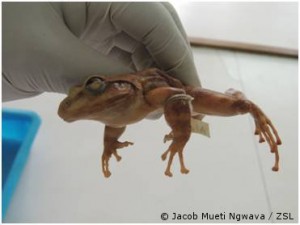
 Since the last week of March, heavy rains have been pouring in Kenya. Catastrophic floods and massive landslides, in which numerous people have lost their lives and property, have been witnessed in various parts of the country. It has, therefore, become practically impossible to navigate the rough terrain of Mt Elgon to search for Du Toit’s torrent frog and surveys have had to be suspended until the rains subside. Du Toit’s torrent frog lives in fast flowing water channels on the mountain, some of which are very deep, and researchers have to work inside these streams to survey for the frogs, so it can be very risky.
Since the last week of March, heavy rains have been pouring in Kenya. Catastrophic floods and massive landslides, in which numerous people have lost their lives and property, have been witnessed in various parts of the country. It has, therefore, become practically impossible to navigate the rough terrain of Mt Elgon to search for Du Toit’s torrent frog and surveys have had to be suspended until the rains subside. Du Toit’s torrent frog lives in fast flowing water channels on the mountain, some of which are very deep, and researchers have to work inside these streams to survey for the frogs, so it can be very risky.
While waiting for the rains to subside, I’ve been studying the characteristics of other torrent frogs so I have a better understanding of the sort of characteristics Du Toit’s torrent frog is likely to have. There aren’t any preserved specimens of Du Toit’s torrent frog in Kenya, but we are lucky enough to have a few specimens of other members of the genus Petropedetes in the herpetology section of the National Museums of Kenya (where I work). These include Petropedetes martiensenni (the Usambara torrent frog), which is endemic to the Usambara Mountains in Tanzania, and Petropedetes natator (the Sierra Leone water frog), which was collected from high altitude forested riverine habitats in Liberia.

The tips of these frogs’ heads are sharply pointed and I think it’s shaped like this to reduce the impact of water pressure on the frog. They have very large eyes and a clearly visible tympanum which is smaller than the eyes. The fore limbs are stout and masculine, a characteristic enabling them to strongly attach onto the rock surface against the swift water flow.
I hope to experience similar characteristics when I finally encounter Du Toit’s torrent frog.
To learn more about Jacob’s EDGE Fellowship project, please visit his community page.
